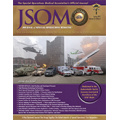Commercial and Improvised Pelvic Compression Devices: Applied Force and Implications for Hemorrhage Control
Bailey RA, Simon EM, Kreiner A, Powers D, Baker L, Giles C, Sweet R, Rush SC 21(1). 44 - 48 (Journal Article)
Uncontrolled hemorrhage secondary to unstable pelvic fractures is a preventable cause of prehospital death in the military and civilian sectors. Because the mortality rate associated with unstable pelvic ring injuries exceeds 50%, the use of external compression devices for associated hemorrhage control is paramount. During mass casualty incidents and in austere settings, the need for multiple external compression devices may arise. In assessing the efficacy of these devices, the magnitude of applied force has been offered as a surrogate measure of pubic symphysis diastasis reduction and subsequent hemostasis. This study offers a sensor-circuit assessment of applied force for a convenience sample of pelvic compression devices. The SAM® (structural aluminum malleable) Pelvic Sling II (SAM Medical) and improvised compression devices, including a SAM Splint tightened by a Combat Application Tourniquet® (C-A-T; North American Rescue) and a SAM® Splint tightened by a cravat, as well as two joined cravats and a standard-issue military belt, were assessed in male and female subjects. As hypothesized, compressive forces applied to the pelvis did not vary significantly based on device operator, subject sex, and subject body fat percentage. The use of the military belt as an improvised method to obtain pelvic stabilization is not advised.


 Español
Español 




